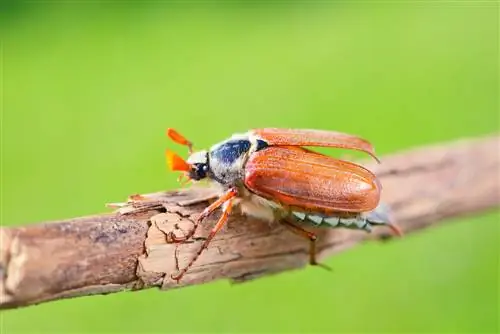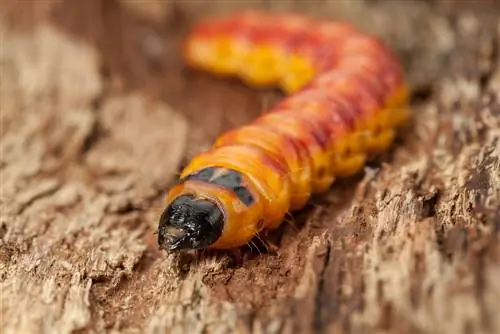- Author admin [email protected].
- Public 2023-12-26 14:17.
- Last modified 2025-06-01 06:02.
The cockchafer is the symbolic figure for the dramatic change in nature. Once vehemently fought against as a plague with tons of poison, a mass outbreak is now considered a well-noticed sensation with great media hype. We introduce you to the buzzing herald of spring with a great appetite.
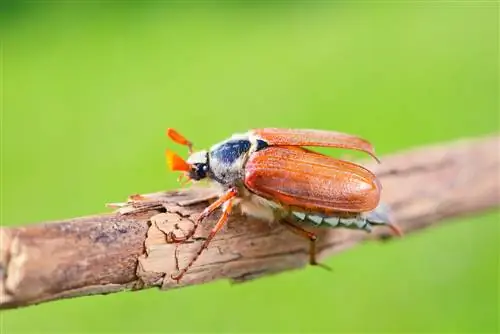
- Cockchafers hum loudly, are 2-3 cm tall, have red-brown wings and conspicuous antennae fans with 6-7 lamellae.
- May beetles crawl out of the ground in spring, prefer to eat tree leaves and have a short lifespan of 4-7 weeks.
- A cockchafer larva is cream-colored, has 6 legs, is as thick as a finger, lives in the ground for 3-4 years and feeds on plant roots.
Cockchafer portrait - profile and lifestyle
When big buzzers buzz comfortably through the air on warm May evenings, it's cockchafer season. The clumsy flight is due to the shape of the body, but at the same time it symbolizes the heavy burden of prejudices that cockchafers carry around with them today. Widespread mass proliferation with denudation of tree crowns branded cockchafers as a dreaded pest until the middle of the 20th century. Today, mass flight years are rare and limited to local occurrences. Most children, teenagers and young adults have never seen a cockchafer live and in color. The following table summarizes important features of life and lifestyle:
| Features | |
|---|---|
| Size | 20-30 mm |
| Cover color | red-brown |
| hind wing | skinny, transparent |
| Color Body | black with white hairs |
| Physique | oval, tapering abdomen |
| Body Drawing | white jagged edges |
| Sensor | 6- to 7-lobed antenna compartments |
| Insect family | Scarabaeidae |
| Most common type | Field cockchafer (Melolontha melolontha) |
| Common species | Cockchafer (Melolontha hippocastani) |
| Food Cockchafer | Foliage forest and fruit trees |
| Lifespan Imagines | 4 to 7 weeks |
| Larva (Grub) | cream-colored, brown head |
| Food cockchafer larva | Roots, tubers |
| Lifespan larva | 3 to 4 years |
Field cockchafers and forest cockchafers are largely similar in appearance and lifestyle. Differentiating between the two types represents a challenge even for the experienced specialist. For this reason, the two conspecifics are considered together here under the term May beetle. In-depth information on the above fact check provides the following important questions and answers:
What does a cockchafer look like?
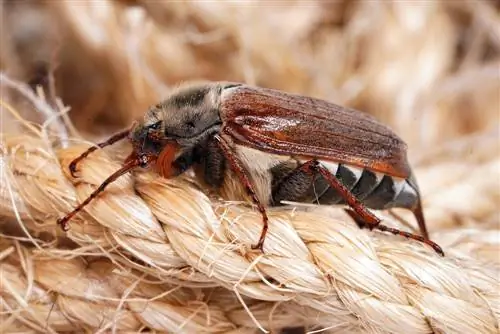
The white jagged flanks are a typical identifying feature of cockchafers
Cockchafers have a round-oval body shape that tapers to a point at the back and is two to three centimeters long. Wings, legs and antennae are reddish brown. The head, chest and abdomen are black with thin, whitish hair. What is noticeable is a jagged, white marking on the flanks of the abdomen. The abdomen itself is not covered with wings. Four longitudinal ribs can be seen on each reddish-brown cover wing. The trademark of a cockchafer is its distinctive antennae with a fan-shaped club at the top. Male cockchafers have a fan made up of seven slats. There are only six of the beetle ladies. The antennae of a male are almost twice as long as those of a female.
What do cockchafers eat?
Adult cockchafers are true eating machines. The menu includes leaves from deciduous trees, preferably oak and beech. The leaves of fruit trees are also not ignored. In gardens and parks, the hungry beetles like to feast on the leaves of maple trees. Once all the leaves have been eaten, cockchafers inevitably fly to conifers to continue feeding there. It's good to know that the affected trees can easily cope with this damage. By the end of June, at the latest, the trees will compensate for the loss of leaves.
How long do cockchafers live?

Cockchafers spend most of their lives as larvae
Adult cockchafers are only granted a short life of 4 to 7 weeks. When they crawl out of the ground as mature adults, cockchafers have already spent 3 to 4 years of their life as larvae. As soon as they emerge from the doll's cradle deep in the ground, two important tasks are on the schedule: eating and breeding. A wasteful maturational feeding period precedes mating. Male cockchafers die immediately after mating. Female cockchafers live a little longer to lay eggs.
Where can you find cockchafers?
Cockchafers prefer to stay near their food sources. Larger populations are mainly found where the soil is loose, sandy and easy to dig. The habitat therefore extends over the following areas:
- Deciduous and coniferous forests
- Heathlands in the north and east
- Forest areas on the Upper Rhine
- Orchards and orchards
No cockchafers can be found in swampy, dry or rocky landscapes.
What does the year of the May beetle mean?
A cockchafer year occurs in cycles of three to four years. During this time interval, the beetles appear in large swarms and eat trees bare. The reason for this is natural population fluctuations as an ingenious survival strategy. The development of the larvae into grubs takes between three and four years. As if the cockchafers had agreed, armies of adult beetles synchronously embark on their maiden flight in May.
Researchers suspect that cockchafers use this method to outsmart their predators because birds or bats can never be sure how many beetles will be available as a food source in a year. A main flying year is followed by two to three years with a minimal beetle population in fields and forests. This cycle is overshadowed by a mass influx every 30 to 50 years, when millions of May beetles develop into a plague above and below ground.
Is the cockchafer a pest?
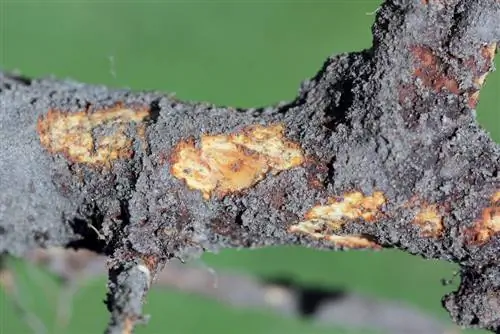
Cockchafer grubs cause great damage to roots
This question has always been controversial in Germany. Conservationists and beetle lovers revere cockchafers as lovely harbingers of spring. Forest owners, farmers and gardeners consider the fat burrowers and their voracious larvae to be pests. The maturation of hatched beetles on tender spring leaves slows down the growth of the trees. The damage caused by grubs in the soil is more fatal. Particularly in cockchafer years and when there are masses of cockchafers, insatiable larvae damage tree roots so severely that entire stands of young trees die.
However, today's cockchafer years no longer reach the dimensions of the past, when the whole of Germany suffered from a plague with serious harvest losses. The cockchafer plague of 1911 is legendary, when a whopping 22 million cockchafers were collected from an area of 1,800 hectares. Today, there are stronger occurrences with pest potential in local hotspots, between which there are huge, almost cockchafer-free areas. Pest control measures are therefore increasingly being assessed critically.
Life of a cockchafer larva
While Mr. and Mrs. Cockchafers gain sympathy points from the population, the big larvae have a difficult time. The grubs are blamed for their constant eating of roots in the subsoil for a period of up to four years. During this time, the larvae go through a total of three stages and complete two to three hibernations. We accompany the development of a cockchafer larva from the mating of its beetle parents to the magical moment when it says “cockchafer fly” again:
Egg laying and first year
After mating, the female cockchafer burrows 15 to 25 centimeters deep into the ground. Eggs are laid in one or two clutches, each with around 20 whitish, 2 to 3 millimeters small eggs. Each egg hatches into a larva within 4 to 6 weeks. The young caterpillar immediately goes in search of tasty plant roots. The first molt takes place in late autumn and with it the entry into the second larval stage. Before the onset of winter, the fed-up grub burrows deeper into the ground to avoid the frost. Feeding activity will stop until next spring.
Second year
When the ground temperature exceeds 7 degrees in spring, the cockchafer larva becomes lively. Until late summer, the grub devotes itself to non-stop feeding. The caterpillar constantly becomes longer and thicker. Another molt occurs in September. Now the third larval stage begins with the greatest damage to plants. Only with the onset of winter will peace return until the next season.
Third and fourth years
Following the second overwintering, the fat larva pupates, which now weighs up to 4 grams of live weight. By autumn the metamorphosis is complete and the finished beetle hatches. However, the cockchafer does not leave its pupal cradle until May of the following year. When the adult beetles crawl out of the ground, the countdown for maturation, mating and egg laying begins.
In colder regions, such as northern Germany or in the Alps, the development of a larva into a beetle takes four years. In this case too, a cockchafer overwinteres in its pupal cradle in a frost-proof depth until it digs out of the ground in May for its maiden flight.
Excursus
Record-breaking cockchafer year 2019
In 2019, the Upper Rhine made headlines as a cockchafer hotspot. After a few quiet years, a cockchafer year was expected. Counts of grubs in the ground at the beginning of 2019 confirmed that a mass outbreak was imminent in Rhineland-Palatinate. The natural spectacle amazed experts and residents. Up to 100 million cockchafers emerged from the ground and colonized an approximately 120 square kilometer forest area near Karlsruhe.
In the following video, beetle experts have their say with detailed information about the memorable May beetle year 2019 on the Upper Rhine.

May beetle June beetle - what's the difference?
Not every brown beetle you encounter in spring is called the cockchafer. A distant relative of the scarab beetle family looks very similar to a May beetle and is called the June beetle. Both beetle genera have a similar lifestyle with a strong preference for plant leaves, which is not well received by hobby gardeners. Upon closer inspection, striking differences can be seen between the June beetle and the May beetle. The following table provides an overview:
| Difference | Cockchafer | June beetle |
|---|---|---|
| Size | 22-35mm | 14-18 mm |
| color | red brown and black | dark yellow to light brown |
| Hair | white, spotty, close-fitting | brown, opaque, bristly |
| Special feature | white sawtooth pattern on the side | ribbed cover wings |
| Sensor | 6 to 7-part antenna compartments | 3-part antenna compartments |
| Prime flight time | May | June/July |
| Activity | diurnal | nocturnal |
| scientific name | Melolontha | Amphimallon solstitiale |
| German name | Field cockchafer, forest cockchafer | Ribbed curlew beetle, June beetle |
June beetles are significantly smaller than May beetles. A look at the cover wings clears up any remaining doubts. The June beetle has three raised, yellowish brown ribs on each wing, which identify it as a ribbed curlew beetle. Furthermore, the white zigzag pattern that cockchafers decorate themselves with is missing on the flanks. Although both beetles prefer to swarm out at dusk, cockchafers prefer to devote themselves to the dreaded leaf eating during the day. June beetles, on the other hand, hide during the day and feed under cover of darkness.
Tip
If you find a fat grub in the compost, it is not a cockchafer larva. Rather, you will enjoy the privilege of meeting a descendant of the very rare and protected rhinoceros beetle.
Are May beetles protected?
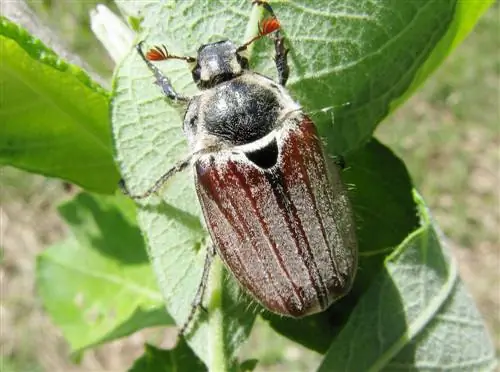
May beetles are no longer threatened with extinction
Cockchafers are currently not threatened with extinction. For this reason, the beetles are not listed on Germany's Red List of Endangered Animals and are not subject to nature conservation.
Things looked completely different in the mid-1970s. In the 1950s and 1960s, mass quantities of tons of highly toxic DDT were vehemently combated. A massive die-off of cockchafers then began. With his famous ballad “There are no more cockchafers” in 1974, the songwriter Reinhard Mey sadly sang the swansong of the big drummers. The musical wake-up call was well received by the population. The former cockchafer plague became a symbol of nature poisoned and destroyed by human hands. When the Federal Biological Institute in Kiel called on citizens to catch May beetles in the same year, only a handful of crawlers were delivered - despite a bounty of a whopping five D-Marks per specimen.
Since then, a lot has happened in favor of the cockchafer. DDT and other poisons were gradually banned nationwide. The result didn't take long to arrive. As early as the mid-1980s, the cockchafer population was recovering, at least in some regions of Germany. In most of the country, the friendly brummers are still very rare to find. Beetle experts and conservationists therefore see the cockchafer in an important flagship function, as a winged representative for countless insect species that are threatened with extinction and urgently need protection.
Background
Turkish cockchafer is protected
A giant from the May beetle family (Melolonthinae) is the Turkish May beetle (Polyphylla fullo). The gem is up to 36 millimeters long. Its dark brown body is decorated with a white spot pattern. The menu primarily includes pine needles, which does not cause any economic damage. Unfortunately, the jewel from Mother Nature's jewelry box is very rare. For this reason, this extraordinary May beetle is listed on the Red List as an endangered species and is protected.
Fighting cockchafers - sensible or yesterday?
There is an increasing rethinking in the fight against cockchafers. Even in problem areas with cyclical mass quantities, foresters and farmers no longer use toxic insecticides for good reason. Combat is only effective during flight with lethal injections from a helicopter. Widespread spraying of toxic substances causes considerable damage to the ecosystem, is considered an outrage against nature and is already frowned upon in the cultivation of food crops. As a result, in many affected locations, a cockchafer infestation is accepted, willy-nilly, as a natural condition. In concrete terms, this means: watching the activity of the May beetles, hoping for an imminent collapse in mass reproduction and supporting bare trees in their recovery with good care.
Fighting cockchafer larvae with beneficial insects
May beetle larvae can attack plant roots in the soil for up to four years. Hobby gardeners do not have to tolerate this devastating behavior. The discovery of grubs in the ground signals that a female cockchafer has chosen the garden as a nursery. The result is stunted growth in trees, bushes, perennials and yellow spots in the lawn. To combat it successfully, get help from the realm of beneficial insects. The nematodes of the Heterorhabditis genus make short work of the eaten caterpillars. This is how it works:
- The best time is in June, about 6 weeks after the cockchafer flight period
- Buy nematodes in specialist stores shortly before the planned control measure
- Dissolve nematodes supplied in clay granules in water according to the enclosed instructions
- Apply beneficial insects with the watering can and attached watering bar
- Keep the affected bed or lawn area constantly slightly moist for several weeks
- Important: Do not lime the bed soil or green area before or after (fertilization is possible)
The microscopic nematodes actively search for grubs. Once they find what they are looking for, they penetrate the body and release a bacterium that is poisonous to the May beetle larvae. Positive side effect: The Heterorhabditis nematode genus does not spare weevil larvae. Of course, the nematodes do not dare to approach a beetle pupa or an adult beetle.
Frequently asked questions
When do cockchafers fly?
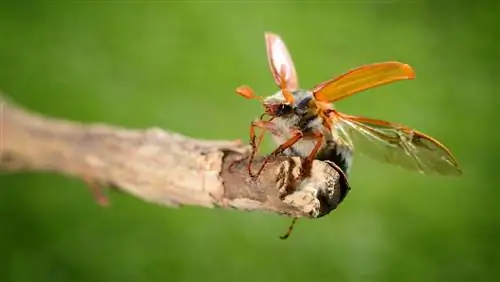
May beetles can be observed from mid-April
When the ground warms up to 7°-8° Celsius in the first warm days of spring, the hatched cockchafers perk up and crawl out of the ground. Without hesitation, they pump their wings several times and take to the air. In the past, the natural spectacle could be admired in May. As a result of global warming, the first cockchafers are already flying through fields and forests from mid-April. Preferred flight time is during dusk.
Can cockchafers sting?
Cockchafers cannot sting. A tapered abdomen suggests that cockchafers could be equipped with a stinging apparatus. In fact, it is the last, visible abdominal segment that is part of the body structure of many beetles. When a May beetle crawls over human skin, it holds on with small barbs on its six legs. This creates a feeling as if the big buzzer was stinging us.
Are cockchafers poisonous to cats?
May beetles are not poisonous to cats. If your cat eats one or two buzzers, it's not dangerous. Of course, too many cockchafers should not be plastered. The hard chitin shell could damage the stomach and intestinal walls. If the beetles are heavy in the cat's stomach so that he vomits the remains, this is likely to be painful due to sharp-edged wing pieces.
Are there still cockchafers?
The cockchafer happily survived the decades-long chemical chases until the 1970s. There has been a steady recovery in the cockchafer population since the mid-1980s. However, cockchafer years and mass occurrences are limited to a few regions, such as the Upper Rhine or the forest areas in Lampertheim in southern Hesse. In many areas, May beetles have become so rare that only the generations of grandparents recognize the beetle when it comes flying in.
Can you fight May beetles with nematodes?
No, nematodes are fighting a losing battle against adult cockchafers. The nematodes have proven themselves as a biological control agent against May beetle larvae because they parasitize the grubs and kill them in the process. The nematodes cannot penetrate the thick chitinous shell of an adult beetle. Nematodes are also ineffective against a beetle pupa.
We found a starving May beetle in the apartment. What to do?
If a cockchafer gets lost in the apartment, it is cut off from its natural food source. Within a short time the beetle is threatened with starvation. Even if you capture the cockchafer and release it outside, it is too weak to forage high up in treetops. By feeding the starving bruster with oak or beech leaves for a while, you can pamper your guest and release him to freedom freshly strengthened.
What attracts cockchafers? What keeps them away?
Cockchafers prefer a habitat with sufficient food sources, such as deciduous trees, bushes and grasses. The beetles like to settle where loose, sandy, permeable soil that is suitable for digging allows them to lay their eggs. If you don't want to attract cockchafers in your natural garden, we recommend regular maintenance work in the bed and lawn. Digging, weeding, raking or mowing are activities that cause disturbance in the soil, which makes life hell for voracious grubs.
Are cockchafers a pest or a rarity?
Cockchafers are both. After a near-extinction in the 1970s, the legendary beetle can now be admired again in some areas. After the Second World War, widespread mass outbreaks were responded to with brutal control measures. The desire to eradicate the pests remained, of course, a pious wish. When the cockchafer population fell to its lowest point in the mid-1970s, a rethink took place in favor of the buzzing harbingers of spring. Thanks to progressive recovery, cockchafer years with a plague character are now developing again in some places. In many parts of Germany, however, the flight of a May beetle is a rarity.
Tip
Female cockchafers have an aversion to hard-working hobby gardeners. If the bed soil is raked and weeded regularly, it will be far too unsettled for egg laying. A lovingly maintained lawn that is mown weekly, scarified and fertilized annually is also despised as a nursery for voracious May beetle larvae.

